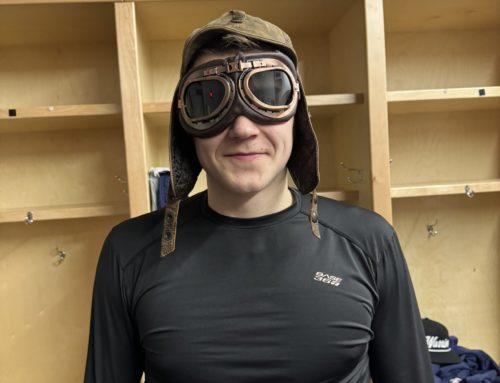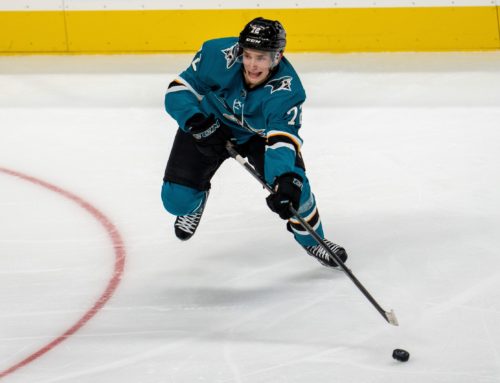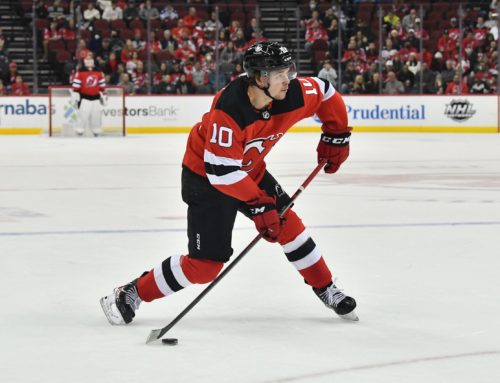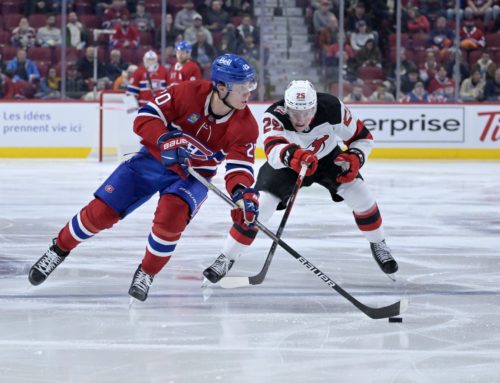Century Mark: Kaliyev and Lundkvist
Alex Wyatt
2023-03-02
Cover Credit: LAKingsInsider.com
Every month, Alex Wyatt digs into some players who have reached the 100 NHL-games-played threshold, as this is the mark, or near it, that many leagues use as their threshold for players casting off their minors eligibility.
Arthur Kaliyev (LAK)
Arthur Kaliyev, 21, is one of many exciting young prospects in the Los Angeles Kings’ stable, yet none possess his pure goal-scoring and shooting tools. In addition to leading the Americans to gold at the 2021 WJC, Kaliyev was a perennial OHL All-Star, drawing comparisons to Alex Debrincat and piling up boatloads of goals in junior. With all this praise, it should be a short path to “obviously you keep him”, right?
Kaliyev finds himself on nearly every fantasy team I manage this season, yet he has strayed into the keep/cut conversation in a few of them. I haven’t been able to find any managers willing to take him on at a price I feel is fair, and there is minimal chatter about him online in the broader sense. Perhaps you feel this as well, and if so, you’re in luck this month.
Now that he has crossed the Century Mark, let’s dive deeper into Kaliyev’s fantasy value moving forward.
Always a goal scorer, Kaliyev has long been praised by scouts for his heavy slapshot, wrister, and snap shot. He put these tools to great use in junior, scoring 126 goals in 192 OHL games, finishing 4th in OHL goal scoring in his second year (three spots ahead of a fella named Jason Robertson), and 5th in his third and final year (four spots behind a fella named Nicholas Robertson).
The 2020-21 season saw him break into the professional ranks, scoring a goal on his only shot in the NHL that year, and potting 14 in 40 games with the Ontario Reign of the AHL. By 2021-22, he was in the NHL for good, suiting up for 80 games, and scoring 14 goals with 13 assists, and thus far this year, he is on an 82-game pace for 21 goals and assists, despite missing some time with injury.
The pedigree is there, and scouts loved him in his draft year, but what do the underlying numbers tell us?
Kaliyev’s scoring pace has increased this year, which is what we want to see from a sophomore player—pacing for half-a-point per game, versus a third last year. His shot rate is down slightly by just under a half shot per game. He’s doubled his hit pace, nearing a hit per game, and is slightly more productive on the powerplay this year than last. These outputs are positive, especially when we look at the right side of the table, seeing his playing time is down a touch, about half a minute less per game, although he is spending more time on the powerplay.
His deployment has been curious: he has played no more than 18% of his time with the same linemates at even strength. It’s not a wonder that some of his underlying numbers seem a bit jumbled, albeit progressing positively.
When Kaliyev is on the ice with these ten combinations, only three don’t have the larger share of shot attempts, and one of those is a 50/50 split. His play driving is a positive sign, and it shows in the player usage chart on Frozen tools.
Todd McLellan is giving Kaliyev more offensive zone starts than the majority of his peers, and he is doing much better with them than the majority of those with similar deployment—while being heavily sheltered, in fairness. On a King’s team that has several long-tenured veterans hungry for what might be one of the last few chances to make the playoffs, it makes sense that a youngster like Kaliyev may be bounced around the line up, especially when he was injured for a stretch. Fellow youngster Quinton Byfield is still learning the ropes, and the thought of the two of them sharing the ice in their prime is an extremely tantalizing potentiality.
All signs for Kaliyev look positive in my eyes, and the fact that he missed some time but is still providing strong per 60 numbers with light deployment gives us a chance to buy low if we don’t already have him. Presuming a 40-goal, 80-point future for Kaliyev might not be the right stance to take, but he appears to have all the tools to reach the 30-goal plateau, and if you have room to keep a young, 30-goal, 65-point winger who has room to grow, I think you’re wise to hold him.
Nils Lundkvist (DAL)
Until recently, Nils Lundkvist, 22, was one of the pieces of the New York Rangers’ embarrassment of riches in terms of young blueline talent lining up behind Adam Fox. While K’Andre Miller and Braden Schneider have carved out meaningful roles with the Rangers, Lundkvist did not get the same opportunity, and a trade request found him sent to the Dallas Stars. In Dallas, Lundkvist is getting the chance to play but is still blocked by Miro Heiskanen.
Now that he is approaching the Century Mark, let’s take a look to see how Lundkvist is earning his keep on the Stars’ blue line, as well as your fantasy squad’s Keeper List.
Taken just inside the first round at 28th overall in the 2018 draft, Lundkqvist was the 12th defenseman off the board. The likes of Rasmus Dahlin (1st), Quinn Hughes (7th), Evan Bouchard (10th), Noah Dobson (12th) and K’Andre Miller (22nd) went before him, each of whom has solidified themselves as solid options on their teams’ respective bluelines. Even players like Adam Boqvist, Ty Smith, and Ryan Merkley had high hopes and high ceilings at draft time, and Lundkvist was mentioned among them.
These days, Lundkvist finds himself more among the latter group of players still searching for consistent NHL traction. Let’s dig into the numbers and see what we can find.
Lundkvist’s career at time of writing spans exactly 76 games, split between 25 games with the Rangers last year and 51 with Dallas this year. He’s seen three minutes added to his ice time this year, nearly all at even strength. Despite the lift in total minutes, he’s only seeing an extra twelve seconds a game with the man advantage. Those extra minutes have been spent nearly exclusively with one of Ryan Suter or Miro Hieskanen, with whom he shares 80% of his even strength time on ice.
Regardless of his on-ice partner, the results have been fairly similar, ever so slightly positive Corsi for, with him and his linemate attempting 52.6% of the shot attempts when they are on the ice. The goals haven’t been as positive, with a negative five goal differential with Suter and a negative six differential with Heiskanen.
He doesn’t hit a great deal, being a more offensively minded defenseman, with less than one hit per game, but also, he doesn’t shoot much, less than two per game, while his blocks sit at about one.
He’s not quite the drag the Hakanpaa/Lindell pair appears to be, though in fairness to them, it’s not unexpected to lose the shot attempt share when two thirds of your shift starts are in your own zone.
Given that Heiskanen is the straw that stirs the drink for the Dallas offense from the back end, Lundkvist will always play second fiddle to him. Heiskanen has the experience, the track record and the pedigree, and is only a year older than Lundkvist. Barring a herculean step forward, which is unlikely, Lundkvist likely projects as a PP2 guy, and though he gets less choice deployment compared to Heiskanen, he will likely continue to see sheltered minutes as opposing teams put their most difficult competition out versus Miro.
Thomas Harley is another young offensive defenseman in the system, one year junior to Lundkvist, who seems to have stalled out slightly in his development, not seeing any uptick to his offensive production over three seasons in the AHL.
Where does this leave us if we hold Nils Lundkvist on our farm? The usual caveat of league-specific depth and team make-up hold true here. Defensemen take a longer time to reach their potential than forwards, and with the minimal production we get from Lundkvist right now he makes a difficult hold. If you’re a long way from a competitive window, or your roster is deep enough, keeping him on your team while he matures and grows his game won’t be as difficult as it would be if you were challenging for a cup, or stricken with minimal keepers.
Lundkvist is a player I would shop at this point, as I don’t think his ceiling is as high as some of the other, still minors-eligible defensemen you could target, or even draft this summer. This isn’t to say Lundkvist will never pan out and provide offense, or he wouldn’t have been given several hundred words in an article, but the opportunity at the moment doesn’t seem ripe to explode offensively, and his production when he isn’t providing power play points doesn’t give enough dividends that I’d want to carve out a keeper spot for him at the moment. He could be dealt for a peripheral-providing, 30-point defenseman if you have a rebuilding squad in your league who could spare the time to invest in his development.
Only time will tell.






